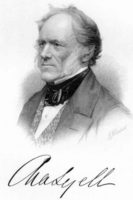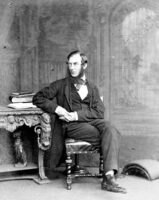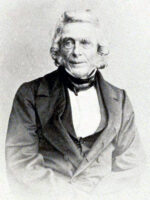
Charles Darwin’s 1842 “brief abstract” describing natural selection has traditionally been touted as natural selection’s original and first explanation. However, two other naturalists, Alfred Russel Wallace and Patrick Matthew, are now known to have independently predated Darwin’s 1842 abstract with parallel natural selection theories.
Alfred Russel Wallace
Naturalist Alfred Russel Wallace (pictured left), working in the South Pacific, published a paper entitled “On the law which has regulated the introduction of new species” in the Annals and Magazine of Natural History in 1855. The paper, written in the Indonesian state of Sarawak, also known as the “Sarawak Law” paper, noted –
“Every species has come into existence coincident in time & space with preexisting species.”
Charles Lyell (pictured right), a close friend, soon alerted Darwin of Wallace’s parallel similarities. Darwin recalls Lyell’s advice in his Autobiography –
“Early in 1856, Lyell advised me to write out my views pretty fully, and I began at once to do so on a scale three or four times as extensive as that which … followed in my Origin of Species.”
Wallace met Darwin twice shortly after that and sent a letter to Darwin. While Wallace’s first letter has yet to be found, in May 1857, Darwin sent an encouraging letter to Wallace stating –
“By your letter & even still more by your paper in Annals, a year or more ago, I can plainly see that we have thought much alike & to a certain extent have come to similar conclusions.”
Parallel similarities seemed to stem from a similar influence. A year later, Darwin received another letter from Wallace on June 18, 1858, holding the unexpected “similarity” clue.
 While this letter is also missing, Wallace described the letter in his autobiography entitled My Life written in 1905. The letter acknowledged the influence of Thomas Robert Malthus’s (pictured left) 1798 essay “without which I should probably not have hit upon the theory of natural selection.” Wallace continued –
While this letter is also missing, Wallace described the letter in his autobiography entitled My Life written in 1905. The letter acknowledged the influence of Thomas Robert Malthus’s (pictured left) 1798 essay “without which I should probably not have hit upon the theory of natural selection.” Wallace continued –
“One day, something brought to my recollection Malthus’s ‘Principles of Population,’ which I had read about twelve years before. I thought of his clear exposition of ‘the positive checks to increase’ – disease, accidents, war, and famine – which keep down the population of savage races to so much lower an average than that of more civilized peoples.”
Acknowledging the surprising similarities to his theory, Darwin notes that the effect of Wallace’s 1858 letter in his Autobiography –
“But my plans were overthrown, for in the early summer of 1858, Mr. Wallace, who was then in the Malay Archipelago, sent me an essay On the Tendency of Varieties… this essay contained exactly the same theory as mine.”
 In Wallace’s 1858 letter, he asked Darwin to forward his enclosed paper entitled “On the Tendency of Varieties to depart indefinitely from the Original Type” to Lyell for presentation at the next Linnean Society (pictured right) meeting.
In Wallace’s 1858 letter, he asked Darwin to forward his enclosed paper entitled “On the Tendency of Varieties to depart indefinitely from the Original Type” to Lyell for presentation at the next Linnean Society (pictured right) meeting.
 On August 20, 1858, Lyell and Joseph Dalton Hooker (pictured left) arranged for the joint readings of Wallace’s paper and Darwin’s 1844 Essay – since neither planned to attend the meeting. Reading the papers generated little interest afterward the meeting.
On August 20, 1858, Lyell and Joseph Dalton Hooker (pictured left) arranged for the joint readings of Wallace’s paper and Darwin’s 1844 Essay – since neither planned to attend the meeting. Reading the papers generated little interest afterward the meeting.
Given a sense of urgency to be the next to publish, the rush was on to complete his theory of natural selection. More than 20 years after returning from his five-year global voyage on the HMS Beagle, Darwin published the first edition of The Origin of Species in November 1859.
Calling it “one long argument,” following two decades in the making and backed by more than 16,000 lines of text, Darwin’s book unleashed an unparalleled scientific and cultural revolution.
Patrick Matthew
Parallel similarity, however, also extends to Patrick Matthew (pictured right), a Scottish naturalist, a less commonly known connection. 
Twenty-eight years before the publication of the Origin of Species, Matthew preceded Darwin’s “survival of the fittest” argument in his book entitled “On Naval Timber, and Arboriculture” –
“As Nature, in all her modifications of life, has a power of increase far beyond what is needed to supply the place of what falls by Time’s decay, those individuals who possess not the requisite strength, swiftness, hardihood, or cunning, fall prematurely without reproducing—either a prey to their natural devourers, or sinking under disease, generally induced by want of nourishment, their place being occupied by the more perfect of their own kind, who are pressing on the means of subsistence.”
Darwin denied reading Matthews’s book. However, Darwin’s wife, Emma, corresponded with Matthew, and in the Origin of Species, Darwin referred to other naturalists professionally connected to Matthew.
Thomas Robert Malthus, Alfred Russel Wallace, and Patrick Matthew predated Darwin’s 1842 “brief abstract,” near-identical concepts Darwin applied to describe his theory of natural selection; the theory was popular long before the publication of the Origin of Species in 1858.
Parallel Natural Selection Theories is a subcategory of Natural Selection.
Darwin Then and Now is an educational resource on the intersection of evolution and science, highlighting the ongoing challenges to the theory of evolution.
Move On
Explore how to understand twenty-first-century concepts of evolution further using the following links –
-
- The Understanding Evolution category showcases how varying historical study approaches to evolution have led to varying conclusions. Subcategories include –
- Studying Evolution explains how key evolution terms and concepts have changed since the 1958 publication of The Origin of Species.
- What is Science explains Charles Darwin’s approach to science and how modern science approaches can be applied for different investigative purposes.
- Evolution and Science feature study articles on how scientific evidence influences the current understanding of evolution.
- Theory and Consensus feature articles on the historical timelines of the theory and Natural Selection.
- The Biography of Charles Darwin category showcases relevant aspects of his life.
- The Glossary defines terms used in studying the theory of biological evolution.
- The Understanding Evolution category showcases how varying historical study approaches to evolution have led to varying conclusions. Subcategories include –


